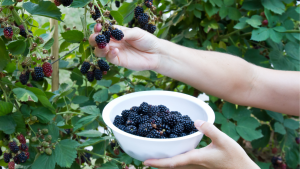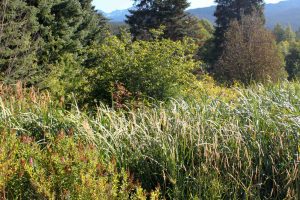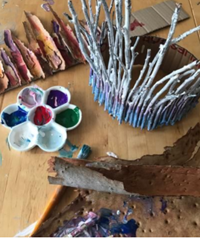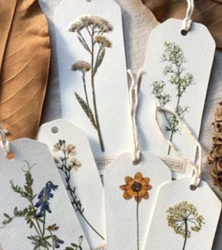
Before You Start
Please do NOT grow or purchase your own invasive plants for these activities.
If you cannot find a specific invasive plant for an activity, consider using a different plant or try a different activity.
The best way to gather invasive plants for any crafts is through foraging.
Here are a few tips that will ensure your safety and the protection of the ecosystem while foraging:
1. Know what you’re foraging for
When foraging for invasive plants, make sure you know how to identify them. iNaturalist is a great way to identify plants while out in the field; you can also refer to our invasive species profile pages to learn more about different species.
Not all invasive species are suitable for crafting, some of them are toxic or dangerous. Please be informed about what you’re foraging for.

2. Know whose land you are on
Before you head out foraging, make sure you have permission to take plant material from the land. In Canada, foraging on public land is allowed, but not in provincial or national parks.
- Don’t forage on private property unless you have explicit permission from the property owners.
- Don’t forage in provincial or national parks in Canada. Removing material from a provincial park is illegal.

3. Avoid areas treated with herbicide
Depending on where you live, some invasive species growing nearby may be treated with herbicide. On public land in the Sea to Sky, there will always be signs in the area warning of herbicide application; keep any eye out for these signs and avoid collecting materials for your crafts in these areas.
If you are curious about how SSISC uses herbicides, check out this blog post about herbicide use and safety.

4. Remove invasives properly
Don’t leave clippings or plant parts in the area where you are foraging, as some plants have the ability to re-root and grow back. For other invasive plants like Common Burdock, removing just the leaves but not the root can encourage more growth.
Make sure you follow your region’s disposal recommendations to ensure you aren’t encouraging the spread of invasive species through your foraging.
Please refer to our Invasive Plants Profile Page to learn about proper removal.

5. Avoid foraging or crafts with Knotweed
Knotweeds are hardy invasive plants that are extremely difficult to remove. Invasive knotweed plants are commonly treated with herbicide, as manual removal is ineffective on these species. Furthermore, their potential of spread is extremely high – even the smallest fragment of plant material can cause a new infestation. To minimize the chance of spread, it’s best to leave knotweed alone and craft with other plants instead.
6. What to do with the leftover materials from invasive plant crafts?
If you have plant parts leftover from your crafts (such as clippings, scraps, pulp, etc.), please do NOT compost the plant material, no matter how insignificant it may seem. Always dispose of invasive plant parts in the garbage to minimize the further spread of invasive species in the area.
Please visit the Disposal Recommendations page to learn more.

While you will likely find lots of DIY uses for knotweed online, we think it’s best you stay away. (Photo credit; Steve Ansell, iNaturalist)
Crafts for Kids
Leaf Rubbings
Making leaf rubbings is easy, fun and uncomplicated – all you need is a leaf, paper and crayons! Try leaf rubbings with Common Burdock, Yellow Lamium or English Ivy (or any other invasive plant leaves!)
Invasive plant dye
Painting with naturally made colours is a fun way to teach kids about the world around them! The Invasive Species Council of BC (ISCBC) has a great resources for this activity. Who knew invasive plants could produce so many beautiful colors?
The East Kootenay Invasive Species Council also has a short video on making watercolors with weeds. Check out their video (on the right) to learn more.
Holly and Ivy Wreaths
A great activity for the winter holidays! We don’t have a step by step instruction for this craft – but check out the article below to learn how a class of 6th graders used English Holly to make wreaths.
Once the holidays are over, just remember to dispose of your wreath in the garbage, not the compost!

Invasive Leaf Bugs
During fall, the leaves from our deciduous trees and plants are falling. For a creative nature lover, this is the perfect opportunity to craft with leaves!
In this activity, we recommend creating ‘good bugs’ from BC native leaves and ‘bad bugs’ from invasive plant leaves. Yellow Lamium would be a great leaf to use for ‘bad bugs’ because it is evergreen, invasive and very common on our trails. For information to help you determine which plants are invasive or native, head over to our identification pages.
What you need
- Leaves from invasive plants
- Leaves from native plants
- Glue or double-sided tape
- Scissors
- Paint (optional)
How to
- Head to your local trail, park or backyard to collect invasive and native leaves. Recommendation: pick up some pine needles and twigs for antennae!
- Time to identify! Separate out the leaves you have collected into invasive and native piles. Hot tip: consider using iNaturalist to help with your species ID.
- Get gluing! Leaves can be glued, taped, cut, and painted to become the bug of your dreams.
Earlier crafters
Bugs can be made in so many ways. For small children, we recommend printing or drawing out a bug outline on a plain piece of paper for leaves to be glued to.
Let’s make a mobile!
Why not make a decoration with the wonder-fall bugs you’ve created? To make a bug mobile, tape string to each bug, then staple the strings to a chunky stick.
For educators
Why not integrate this crafting activity into a larger discussion about ecosystems and food webs? Have a look at ISCBC’s Design an Invasive All-Star activity for inspiration!
Invasive Crowns
An eco-friendly Halloween costume made from invasives! Spooky season is the perfect time to learn more about invasive plants with this activity.
Invasive Scotch Broom and English Ivy are recommended for this craft. They are also very common in the Sea to Sky region, but any other woody invasive would be perfect (as long as it’s not thorny or toxic!). For more information on invasive species in the Sea to Sky, check out our invasive species profile pages.
What you need
- Scotch Broom, English Ivy or any woody invasive plant
- Cardboard
- Tape
- Paint (optional)
- Invasive flowers or leaves (optional)
How to
- Head to your local trail, park or backyard to collect the woody invasives of your choice. Pro tip: if you are looking for Scotch Broom and English Ivy, you should be able to find them easily in Squamish.
- Fit a strip of cardboard to the head of the soon-to-be-crowned (prince? queen?). Allow for a few centimetres of overlap, so you can staple, tape or glue the ends together.
- Arrange your invasive plant stems into position on the cardboard base and glue or tape into place.
- Make it extra beauti-fall by painting the stems and adding plant leaves or flowers to the band!
Caution
- English Ivy causes skin irritation in some people, so you may want to test it out before crowning little ones.
- Scotch Broom seeds are incredibly resilient, so we want to avoid spreading them. If seeds are on the plant when you collect the branches, please leave them alone and choose a different plant instead.
Crafts for Everyone
Scotch Broom Baskets
This is a creative use for all the pesky Scotch Broom growing in the Sea to Sky! This craft might look tricky, but it’s perfect for DIYers who are good with their hands. Also, a Scotch Broom basket could have so many uses! A jewelry holder? A place to put spare change? A pencil box? A big basket to hold all your little baskets? The possibilities are endless!
Ivy Weaving
If you aren’t keen on Scotch broom baskets, maybe Ivy weaving is your thing! One of the best things about this craft is how few tools you’ll need to get started – and the basket is made out of 100% ivy. (Video credit: Free the Fern)
Paper from invasive plants
Did you know you could make natural, home-made paper from plants? In the video to the right, the creator uses Common Reed, but plant paper can be made from any plants that contains sufficient cellulose fiber (You could try Common Burdock, or Himalayan Balsam?) . This craft could give a new spin on decorative cards or notes!
Note: Common Reed is not known to be present in the Sea to Sky, but if you think you’ve spotted, please report it!
Invasive plant herbarium
Herbariums are fun, beautiful and educational. iNaturalist is a great app to help you identify invasive species while out in the field. Making an invasive plant herbarium can be a great way to familiarize yourself with the invasive plants growing in your neighborhood.

Blackberry dye
If you get tired of eating invasive blackberries, check out this tutorial for dying yarn with blackberry juice. The same method might even work on other fabrics! We can’t wait to see all the handmade blue-purple scarves and hats you’ll create!

Herbarium bookmarks
Fall brings cozy evenings curled up inside with your favorite novel. Why not make use of the fallen leaves outside to make plant press bookmarks? This craft is a great way to increase your plant knowledge and identification skills. If you fancy learning more about herbariums, have a look at our herbarium page!
What you need
- Leaves of native and invasive plants
- Plant press (two heavy books will do)
- Newspaper
- Cardboard
- Card or double-sided tape
- Glue
- Scissors
- String or ribbon (optional)
How to press plants
- Head to your local trail, park or backyard to play detective and collect invasive and native plant leaves.
- Press those plants! Researchers may use fancy plant presses, but thick phone books (remember those?) or textbooks work (almost) just as well! At SSISC, we use two small pieces of plywood that are tightened using a strap.
- Arrange your specimens between sheets of newspaper, cardboard and then the plant press. Apply pressure for 24 hours.
- After the first day, inspect your specimens and make any adjustments needed to their arrangement.
- Replace the damp newspapers with fresh ones to prevent mould.
Depending on the type of plant, they can take anywhere from 2 days to 3 weeks to dry completely. Store the press in a warm place, such as above the refrigerator, and check on the plants often, at least once a week. Once completely dried, you can make your bookmarks!
How to Make Bookmarks
- Cut the craft card into your preferred bookmark size.
- Cut out small labels with the plants’ common names; also note whether it is invasive or not. This will help you develop your plant ID skills! Hot tip: consider using iNaturalist to help with your species ID.
- Decorate your plain bookmark with the pressed plants and add your plant label.
- We recommend punching a hole the top of the bookmark to tie a piece of string or ribbon for extra flair.








